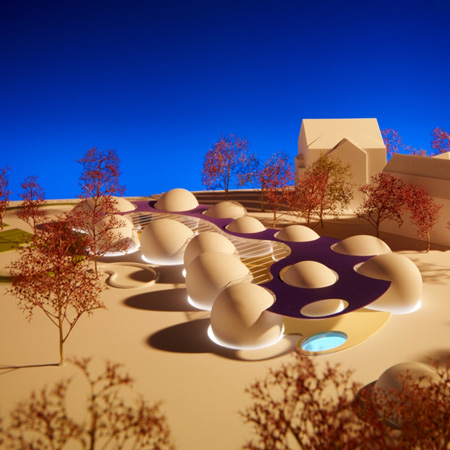
Discovery by GPAC
Dresden studio GPAC have designed a children's nursery for Bühlau in Dresden that looks like 13 eggs.

Called Discovery, the building would include a shared space under the central glass canopy, which could also be used to collect solar energy.
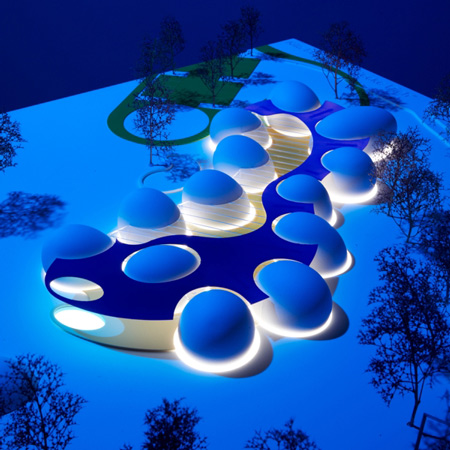
Here are some more details from the architects:
Childcare Center “Discovery“
Design Concept
Climate change, species preservation, conservation of resources, innovations in gene technology and a reduction in CO2 emissions are all topics which seem to permeate our everyday lives and increasingly capture our attention. These topics beg the question, how can we act responsibly today to secure a promising future?
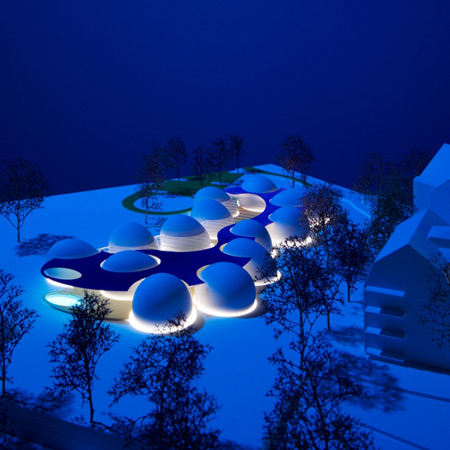
A gradual shift in society is taking place; an increasing readiness to change our habits, rethink our views and prioritize our values.
Acceptance of ecological, social and cultural responsibility for ourselves and the future of our children is spreading around the globe and is being supported by an increasing population. How does all this play a role in the design of a “socially sustainable” childcare center?
The realization of the Childcare Center in Bühlau offers the chance to act on such responsibilities and to design a pre-school that embodies and manifests in its form, construction and material a sustainable and responsible approach to the use of resources and energy. Our goal is to create a childcare center seen as a creative and free space for unrestrained fantasy and a place to freely develop the individual and sensory perception. With all this in mind, GPAC strives to meet the following goals:
- Provide energy CO2 –emission free
- Recycle rainwater and wastewater
- Use low maintenance and maintenance free materials and construction
- Account for the life cycle costs of individual building components
- Analyze the total investment to the year 2050+
- Integrate the local and regional economic markets and research sectors
- Implement ecological products and products with a transparent production chain
- Create a positive and harmonious environment
- Heighten sensual perception, i.e.beauty and haptic
- Awaken inspiration
- Present the children opportunities to conceptualize their own space
- Making contrast tangible, i.e. light and shadow
- Design a tactile experience of how space flows including movement
- Convey good architecture and responsibility for the environment
- Offer numerous and various uses of space
Integration in the City Fabric
The building, with its uniqueness, clear identity and scale, integrates itself harmoniously in the surrounding environment. Similar to large “eggs,” the individual forms are nestled in the green spaces, part of the exterior landscaping, and clearly distinguish the design. The main building axis runs from southeast to northwest. The building gains its natural daylight from the northeast and southwest areas. The entrance is located on the northern side of the building to the Bautzner Strasse. Two paths lead to the childcare center, one through the avenue of birch trees with parking spaces on both sides and the other curves through the northwest side of the property. Service and emergency vehicles have access to the turnaround, which is otherwise blocked with road bollards. For employees and visitors of the childcare center and visitors to the planned swimming pool, 50 parking spaces are planned.
Concept and Design
The individual child is a key aspect in the design concept. “Discover – Experience – Understand” is the basic model under which various pedagogical concepts can be integrated. With this in mind, the “egg” is the main form used for the childcare center. The whimsical tilting and turning of the forms clearly manifests the playfulness inspiring this design. By freely positioning the “eggs,” interesting spatial relationships and views within the building and to the exterior are created. The children are offered a total spatial experience where discovery and exploration are nurtured. The “discovery zone” connects the “eggs” to create a unified space. The “discovery zone,” in its plurality of design stimulates the children and aids in the development of their sensory perception through hearing, seeing, feeling and smelling. The “discovery zone” is a commons area to be used multi-functionally for various group activities such as arts and crafts, exercise, theater and stage productions or simply for festivities. The room “Blind Man’s Bluff,” found over the sanitary tract, can be fully darkened and used as an observatory or planetarium. The glass roof is to be printed with a graphic or floral pattern. The interplay of “open” and “closed” roof spaces creates interesting sunlight patterns and illuminates mythical creatures on the walls and floor spaces.
Function and Organization
The design concept integrates all the rooms essential to the childcare center into the ground floor. Both the east and west entrances are located on the north side of the building. Directly adjacent to the entry, is the central cloakroom and the parking area for buggies as well as the Director’s Office and the kitchen area complete with storage and waste disposal areas. The upper story of this form houses a conference and lounge area in addition to the sanitary tract and dressing rooms for personnel. The technical rooms and maintenance work areas are located on the basement level.
Individual rooms for the infant groups are located near the entry area. Attached to this tract are the sanitary and shower areas with the dark room “Blind Man’s Bluff” located on the upper level. Across from these rooms is the multi-purpose room, followed by the six daycare group rooms and theme rooms. Each group room is equipped with at least one toilet and a sit and play raised platform, which simultaneously serves as storage space. On the exterior walls of the group rooms, in the “discovery zone,” molded seats are part of the walls. The play and “rolling hill” outside on the playground also provides storage for outside toys.
Construction and Material
A sustainably designed construction and details combined with ecological materials and products provide the basis for the design. The construction concept utilizes the best material resources available. High performance and dual-purpose constructions with integrated functions are key indicators of the building’s sustainability. GPAC conceptualizes the structure as a double- wall textile reinforced concrete (TRC) shell construction. TRC optimizes the construction by reducing mass and ultimately reducing the necessary raw materials for construction as compared to conventional structures. This design showcases the advantages and enormous performance potential of double-curved construction, similar to an egg with its ideal ratio of stability to material thickness. In addition to its strength in form and function, the “eggs” charm us with their aesthetic appeal. Because the structures are derived from just one form, they are very similar and allow for serial production making the realization of the building economically viable. All conventional roofing construction, wind and waterproofing and drainage are omitted. Surface water can be collected (up to 90%) in near-ground water gutters and biologically treated for secondary water use.
The “discovery zone” located between the “eggs” is designed as a solar collector. The roof is to be constructed of frameless triple-glazed panels completely made of glass and supported by tension cables between the glass layers. The glass surface is to be slightly sloped to aid in drainage. State of the art technology enables approximately 35% of the glass roofing to be coated with semi-transparent photovoltaic modules. The solid concrete slab, constructed of a lightweight concrete with a clay aggregate (Liaporbeton), is bedded on lava gravel and serves as a heat store.
Energy Concept
Based on the operational hours of the building, the energy concept chosen is a hot and cold air forced ventilation system with heat recovery. At four individual intersecting coordinates in the room, the air is distributed in the space between the textile reinforced concrete shells. Near the top of the room, the treated air flows into the room through the open pores of the surface plaster at designated openings in the wall. The air returns are located in the floor and are used for heat recovery. The porous plaster also takes on hygroscopic and acoustic functions. It is expected that the room’s smooth and rounded shape will be extremely effective to this purpose.
The central air conditioning mixes the return air from the heat recovery vents with filtered fresh air to meet the requirements set for each individual room’s climate and air quality. The conditioned air flows into the rooms through a ventilation system to be located approximately 4 meters underground. The system is to be equipped as a highly flexible and efficient system with quick time response to adjust to fluctuating exterior weather and temperature parameters.
The “discovery zone” serves as a passive thermal source where the air is warmed and returned to the ventilation system through the return vents located in the floor. The group rooms can be individually regulated for maximum comfort and flexibility to meet each group’s individual needs. When desired, the individual room’s humidity can be regulated and even fragrances can be added. The system is practically maintenance free, very efficient and can be operated without CO2 emissions. Outside of operating hours, the ventilation system simply recirculates the air. The electrical energy required for pumps, filters and controls in the ventilation system, the lighting in the building and the kitchen appliances can be supplied by the integrated semi- transparent photovoltaic roof modules or by a fuel cell.
With the realization of the Childcare Center, GPAC wishes to relay the importance of a holistic awareness and shaping of our environment.
See also:
.
 |
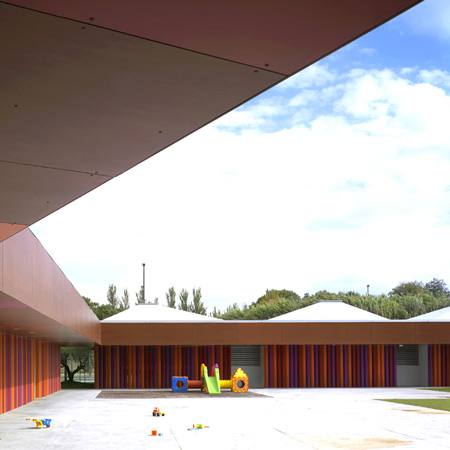 |
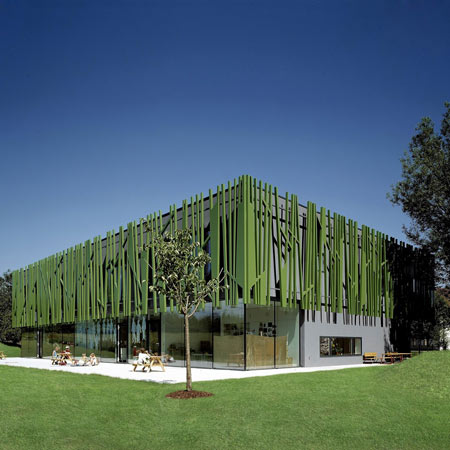 |
| Lomme bed by Cycle 13 |
Kindergarten in Rosales del Cana by Magén Arquitectos | Kindergarten Sighartstein by Kadawittfeldarchitektur |